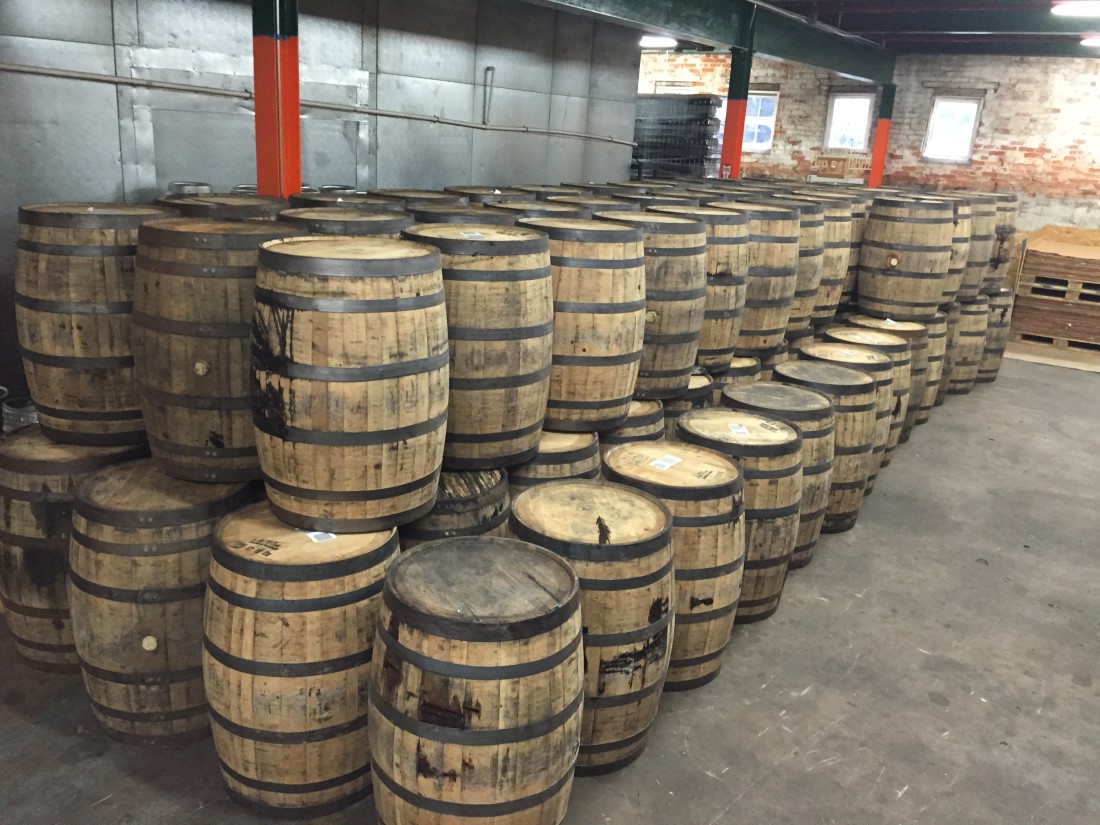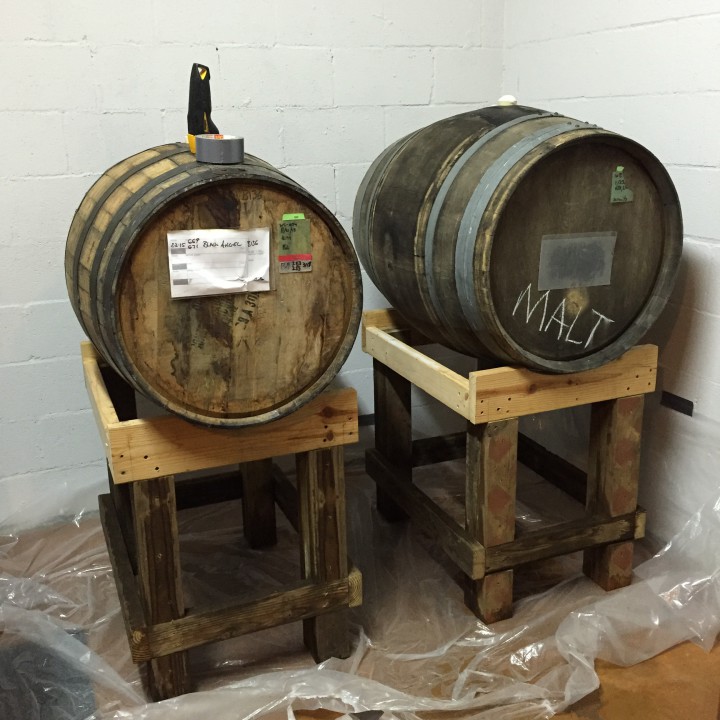The second in a two-part series on barrel aging heads east to Catawba County and visits a couple of neighborhood cellars to explore how Asheville-area brewers are using oak and spirit vessels.
Barrels in the basement
At noon on Saturday, Dec. 12, Wicked Weed Brewing staff opened its Funkatorium to sell retired bourbon, gin, wine and tequila barrels from its sour program to the public. Among those in line were members of Mountain Ale and Lager Tasters, who came away with two barrels — one white wine and one bourbon — for the Asheville nonprofit homebrewing club’s first group foray into barrel-aging sour beer.
Led by MALT minister of education David Maida, a mix of 13 experienced sour homebrewers and novices are collaborating on the project. Drawing inspiration from current industry practices, Michael Tonsmeire’s book American Sour Beer and The Sour Hour podcast hosted by Jay Goodwin, co-founder of The Rare Barrel in Berkeley, Calif., Maida developed simple recipes for a blonde, which went in the white wine barrel, and a red for the bourbon vessel.
“Having a generic sour base and blending that with fruit, spice, hops or other beers is a very popular method in the American sour beer scene,” Maida says.
After the beers age for a couple of months in a MALT member’s basement, the group will remove the barrel’s Vinnie Nail (a stainless steel nail on the barrel’s wooden face, named after Russian River Brewing Co. owner and brewmaster Vinnie Cilurzo) and sample the liquid. Maida says it could easily take a year for the brews to achieve a steady terminal gravity and develop the level of character the group desires — plenty of time for the baker’s dozen to determine the two beers’ end results. Maida says they may opt for a solera, in which half of the beer is removed after six months and replaced with a fresh version, a blending process that yields a more developed product and a quicker return.
The sour beer group isn’t the only MALT subset experimenting with barrels. Five other members purchased a 15-gallon whiskey barrel through a broker from Few Spirits in Evanston, Ill., and had it shipped by freight to David Keller’s Bat Cave home brewery. The quintet filled the barrel with a Russian imperial stout, which they brewed on March 20, using a cold extraction method for the dark grains to keep their harshness low.
“We decided that [beer] would be the most interesting and would utilize the forgiving flexibility of the style,” says Keller, whose group aims to taste the beer regularly after about two months. “It doesn’t take long to impart the whiskey-barrel flavor profile to the stout, and we will try not to over-oak the beer. Sometimes the tannins in the oak can be unpleasant, so we will try to come out with a soft vanilla bourbon flavor with just a bit of oak in the background.”
Barreling ahead
Olde Hickory Brewery started its barrel-aging program in 2005 with five Jim Beam bourbon barrels. Today the brewery has between 550 and 600 barrels, including ones that once held rum, tequila, armagnac, brandy and Scotch whisky. This dedication to oak has made Olde Hickory one of the most distinguished brewers of barrel-aged beers in North Carolina. Of the 5,000 barrels produced at the brewery last year, only 3,000 shipped because the other 2,000 were cellaring in a variety of secondary-use oak.
“Barrel-aged is a huge part of what we do. We spend a lot of time and resources on it,” says Olde Hickory founder, co-owner, brewmaster and host Steven Lyerly. “It’s a significant bit of volume, and we’ll be able to reap some of those rewards this year.”
The brewery’s best-known barrel-aged beer, Event Horizon Imperial Stout aged in bourbon barrels, has been voted the top North Carolina beer on RateBeer for the last three years. Event Horizon was also the No. 1 North Carolina beer on BeerAdvocate until it was dethroned last year by Olde Hickory’s Omega Point, a blend of barrel-aged barleywines developed to commemorate the brewery’s 20th anniversary. Event Horizon also won a 2014 World Beer Cup, Omega Point won the North Carolina Brewers Cup at last year’s North Carolina State Fair and both beers received awards at the Carolina Championship of Beers.
Far from resting on its laurels, Olde Hickory continues to focus on growth and innovation within its barrel program. Last winter saw the release of Calico Jack, a spiced imperial stout aged in rum barrels, and Carolus Magnus, a Belgian-style quad matured in armagnac barrels. Carolus Magnus may see limited distribution in the Asheville market in the near future. In January, the brewery released two variations on its Irish Walker barleywine: Cubano Walker, aged on Spanish cedar, and Appalachian Walker, a brandy barrel-aged collaboration with Charles and Geoff Alexander of Asheville bottle shop Appalachian Vintner. A portion of the proceeds from Appalachian Walker were donated to the autism research nonprofit the Puzzle Pieces Project.
This year promises additional barrel-aged clean beers, including a scotch ale and an imperial stout aged in Macallan single-malt whiskey barrels, both with an expected May release, plus a special project featuring barrels from Utah’s High West Distillery that is slated for release in June. The brewery has also started a sour program, with more than 90 barrels in the basement of its downtown brewpub currently aging five distinct base beers.
Growth in Olde Hickory’s barrel program is about more than just beer. Its success has allowed the brewery to hire several new employees in recent months with more recruitment expected as it expands distribution farther into South Carolina and Tennessee. Lyerly is optimistic about what the growth in craft means for the North Carolina economy: “Being the fourth-oldest brewery in the state, it wasn’t always [this] way. For many, many years it was just a handful of brewers in Western North Carolina slugging it out to try to create a market, and now […] all across the state, it’s a good time to be in the craft beer business.”





Before you comment
The comments section is here to provide a platform for civil dialogue on the issues we face together as a local community. Xpress is committed to offering this platform for all voices, but when the tone of the discussion gets nasty or strays off topic, we believe many people choose not to participate. Xpress editors are determined to moderate comments to ensure a constructive interchange is maintained. All comments judged not to be in keeping with the spirit of civil discourse will be removed and repeat violators will be banned. See here for our terms of service. Thank you for being part of this effort to promote respectful discussion.